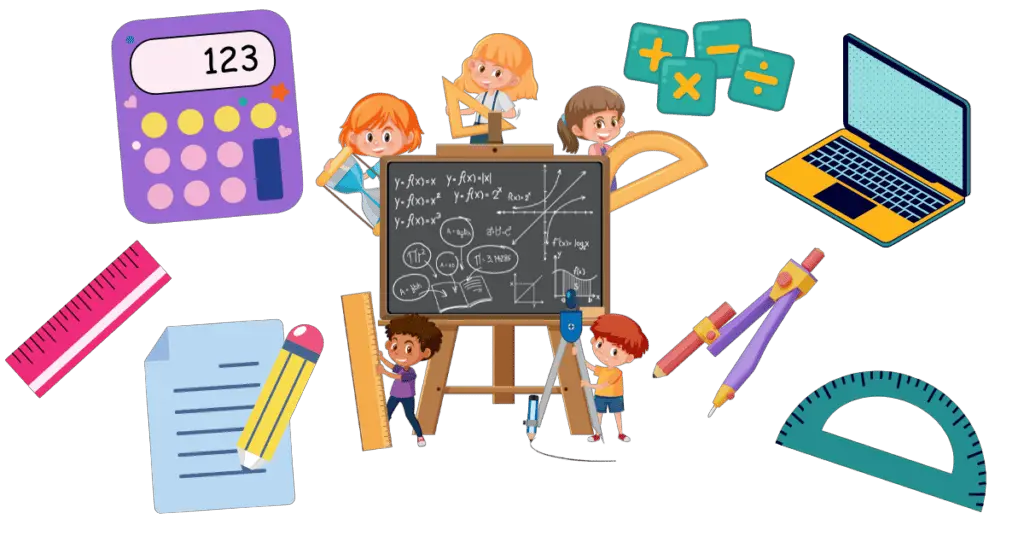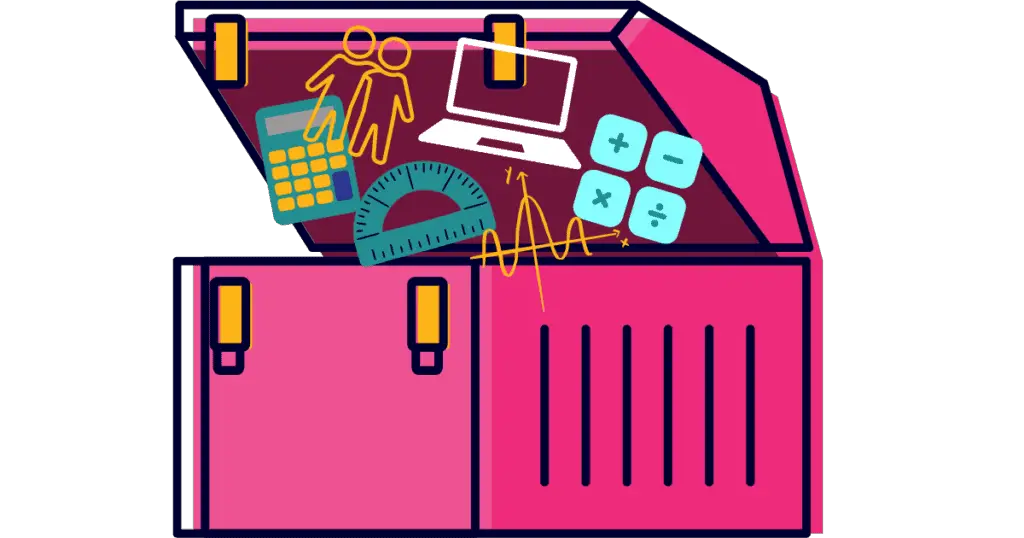
The Common Core State Standards (CCSS) include eight “Mathematical Practices” that teachers and students are encouraged to use throughout their mathematical lives. These are different from the grade-level content standards in a few ways. Firstly, these Mathematical Practices are not grade-specific. Rather, they remain constant practices throughout the child’s education, with the hopes that they become habit. Further, as the words practice and habit imply, these are not mathematical procedures or rules, but are more akin to mindsets and broad strategies.
For a broad look at all eight Math Practices, check out the post What Are the Math Practices and What Do They Have to Do With Me? For a deeper dive into the other seven practices, check out the list at the bottom of this post.

I like to think of the fifth practice as building and learning to use a personal “problem solving toolbox.” The fifth practice is [choosing and] using appropriate tools strategically. When most of us picture math class, we picture learning individual, isolated tools. However, the Mathematical Practices emphasize that simply introducing these tools in isolation is not enough. Rather, to become effective problem solvers, students must learn, explore, and practice these skills enough that they become part of the student’s personal “problem-solving toolbox” from which they can draw as needed.
This post contains affiliate links. If you purchase through these links, I may earn a small commission at no additional cost to you. You can read more about how I choose affiliates and products at my affiliate page.
This post was originally published at mathteacherbarbie.com. If you are viewing it somewhere else, you are viewing a stolen copy.
Being strategic in choosing mathematical tools
- Know the problem you’re trying to solve. Some things to consider in this step include:
- Can you explain the context to someone else using different words?
- Would drawing a picture help you put all the information in its place?
- Is this a multi-step problem, or is the given information exactly what you need to know to answer the question in one step?
- Is an approximate answer okay or is an exact answer needed?
- Have you identified the quantities, and do you know the relationships between them (additive, multiplicative, subtractive, etc)?
- Identify the available tools.
- Operations (counting, addition, subtraction, multiplication, division, exponents, etc)
- Paper and pencil
- Calculators
- Drawings and figures
- Spreadsheets
- Arrays or other models
- Formulas, algorithms, etc.
- Manipulatives or physical representations
- Scissors, paper, clay, etc to build models
- Understand the strengths and limitations of each tool.
- This is learned best by experience, practice, and both mistakes and successes. Part of that play and exploration is learning when each tool is useful, and what the strengths and limitations are.
- Combine tools if necessary.
- If you use a calculator, you may still need to use a drawing or figure to determine whether to add, subtract, multiply, or divide. You may find that building a spreadsheet array is easiest to organize the information (especially in statistics and other data-driven subjects) but that once the data is organized, some calculations are easier to do on paper.
- Practice using the tools.
Supporting this practice at home
In the classroom, your child may have access to tools that just aren’t available at home, such as certain manipulatives like rekenreks (video), fraction circles or bars, base-10 blocks, geoboards, and more (affiliate links). So how can you support this practice both broadly and specifically?
- Make sure your child is practicing each new tool when a problem specifies. It takes a lot of exploration, practice, use, and even misuse to learn when a tools is valuable. Make sure your child is getting the practice with each new tool so that it becomes a part of their own internal “toolbox” that they can draw from when needed in the future.
- Make sure your child has opportunities to choose their own tool whenever appropriate. As the Education Development Center points out in their discussion of this practice, an oft-overlooked component of this Math Practice is opportunities for students to practice choosing their own tools. As choice often does, this builds both autonomy and confidence.
- Resist the urge to immediately correct your child when they choose the “wrong” tool. Trying a tool and finding it doesn’t work is also part of the learning process. In fact, making mistakes and correcting them is one of the most effective and efficient ways to learn. Allow students to make and learn from those mistakes in safe spaces such as the classroom, the home, practice problems, and homework. Instead of immediately correcting them, support them in thinking through a) why the tool didn’t work for this particular problem, and b) what would work better.
- Consider giving a final answer (sometimes “right” and sometimes “wrong”) and asking them whether they agree or disagree. This turns the process into a game, can unexpectedly give insights about where to start when the process feels too overwhelming, encourages evaluating the reasonableness of an answer, and also encourages using multiple processes and tools to prove their guesses.
- Keep it simple with tools such as paper and pencil, and bring in modeling tools around the house such as blocks, paper-scissors-tape, rulers, paperclips, clay or play-doh, etc. Especially for children, but even for adults, movement, modeling, and active exploration are powerful and important for learning and processing.
- Use free online resources. The quality of online resources that are free to educators and families has exploded in the past decade. If you need places to start,
- Desmos.com has great calculators that can be accessed online or downloaded as smartphone and tablet apps.
- Online manipulatives can replicate virtually the tools many teachers use in their classrooms. Polypad at mathigon.org and the apps at the Math Learning Center are among the best at the time this article is published.
- Geogebra.org is one of the early online graphers that has withstood the test of time. It is more popular with college professors than its main competitors because of its more advanced suite of tools, but it also has the basics and is relatively easy to learn. It comes loaded with more tools for geometry topics than some of its competitors.
- Download and print graph paper, lined paper, coordinate planes, and more with a quick internet search. There are oodles of options!
- Sites such as Graspable Math allow students to see manipulations in action, correcting early mistakes when they happen instead of allowing them to continue through a problem. This is particularly useful for topics such as order of operations and early algebra manipulations.
- I would be remiss not to acknowledge Computer Algebra Systems, or CASs, but I also mention them with a bit of caution. These are computer programs that can themselves do some amount of algebra manipulation. They may range from the parentheses and fraction buttons on an expanded basic calculator, all the way to apps such as Wolfram Alpha or Photomath. CASs are frequently used as methods of cheating on homework or even exams. However, they are also extremely useful when used wisely. CASs should not be used as a way to avoid learning certain skills or techniques. Instead, they should be used to examine deeper ways of understanding those skills or techniques, or to speed up menial tasks that were truly mastered in a previous course but arise in solving a different problem later in one’s math journey.
This article is far from exhaustive. However, I hope it helps you think about your own ways to support this very important practice in developing problem solvers out of today’s students. Heaven knows, there will be enough problems for them to solve in their lifetimes.
You’ve Got This!
For a deeper dive into all eight practices, check out the following posts:
MP1: Sense Making and Perseverence
MP2: Abstract and Quantitative Reasoning
MP3: Constructing and Critiquing Arguments
